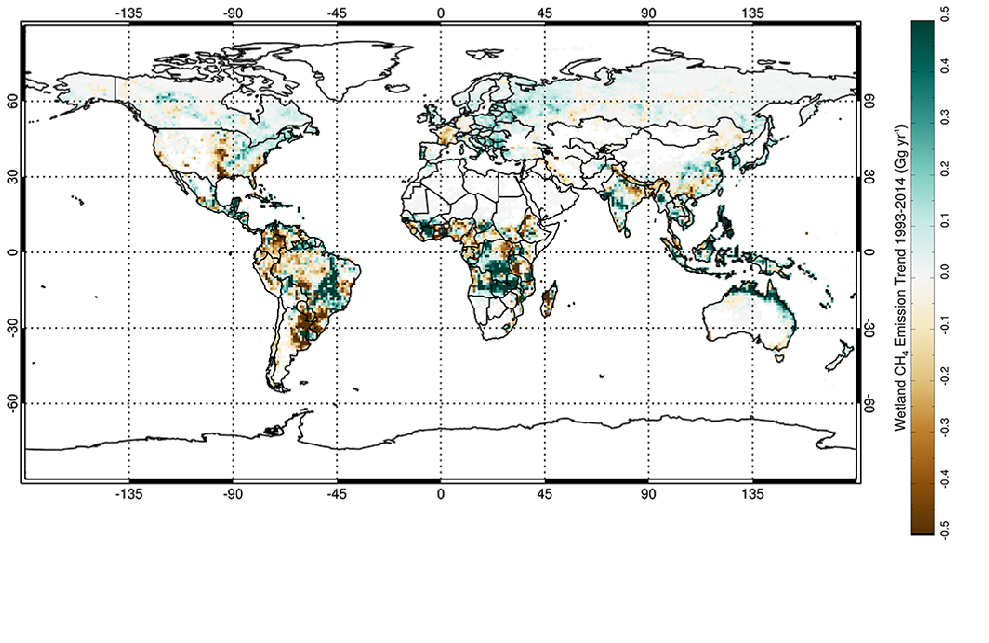
Natural methane emissions
Methane (CH4) is the second most important greenhouse gas, contributing to around 30% of total global warming since the pre-industrial era. Methane has a global warming potential (GWP) of more than 25 times that of carbon dioxide (CO2) over a 100-year time scale but a much shorter lifetime in the atmosphere.
There are still large gaps in the current global methane budget and scientists from NCEO are applying observations and numerical analysis to improve our quantifications of natural and anthropogenic emissions. Global atmospheric concentrations of methane are currently around 1810 ppb, which is approximately 1000 ppb above pre-industrial levels, and the variability in atmospheric growth rate is not well understood.
Besides anthropogenic sources, there are also large natural methane sources that are key to understanding the global methane budget, but they are often challenging to quantify and have large uncertainties. We need a better understanding of the methane budget and how emissions from natural sources will change with further warming levels.

Natural sources of methane include:
- Wetlands – methane-emitting microbes (methanogens) thrive in anaerobic environments such as waterlogged soils present in wetlands and oxygen-poor freshwater reservoirs. Wetlands are the largest source of natural methane, contributing between 20-40 % of total global methane emissions.
- Termites – methanogens are also produced in the digestive system of termites. Methanogens break down organic matter and produce methane gas.
- Geological processes and oceans – thermogenic methane is formed over millions of years through geological processes and can be released into the atmosphere through natural features such as terrestrial and marine seeps and mud volcanoes.
- Wildfires – pyrogenic methane is generated by the incomplete combustion of biomass and soil carbon, such as that occurring during wildfire.
Methane warms the Earth’s climate 80 times more powerfully than carbon dioxide, although it remains in the atmosphere for a much shorter time (around 10 years).
At NCEO we use a range of satellite observations, climate models and machine-learning methods for:
- Improved modelling and quantification of methane from wetlands.
- Better mapping of wetland extent.
Projects
Dr Robert Parker and Dr Cristina Ruiz Villena, from NCEO University of Leicester, are leading a work package to derive improved estimates of methane from wetlands using EO data, machine learning and the Joint UK Land Environment Simulator (JULES). This activity is part of the European Space Agency (ESA) Climate Change Initiative (CCI) Climate Users Modelling Group (CMUG) project.
Dr Robert Parker, from NCEO University of Leicester, has been awarded a Future Leaders Fellowship to work on improving wetland extent and methane emissions estimates.
Tools
The Joint UK Land Environment Simulator (JULES) is the land component of the UK Earth System Model (UKESM), which is a state-of-the-art Earth system model developed by the UK Met Office in collaboration with the Natural Environment Research Council (NERC), and is regularly used in international climate assessments such as the Intergovernmental Panel on Climate Change (IPCC). JULES simulates energy, water and carbon exchanges in the terrestrial ecosystems, and is used by NCEO researchers to model methane emitted from wetlands.
Observations from low-Earth orbit satellites such as the TROPOspheric Monitoring Instrument (TROPOMI) from the European Space Agency (ESA) and the Greenhouse Gas Observing Satellites (GOSAT and GOSAT-2) are used to monitor and quantify methane emissions from natural as well as anthropogenic sources, and to improve the models.
Contact
For further information contact Dr Robert Parker, University of Leicester or Professor Paul Palmer, University of Edinburgh

Related content:






